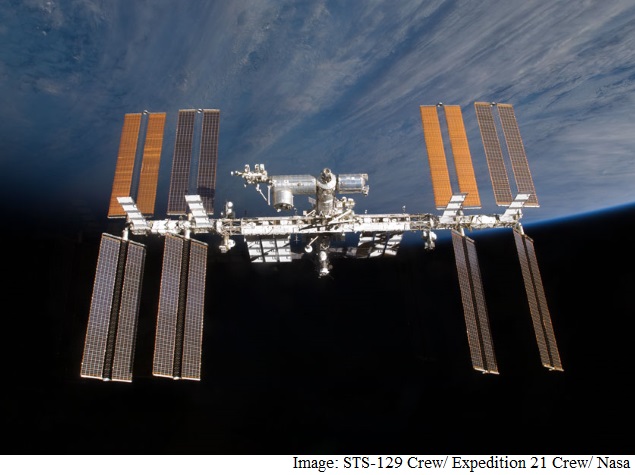- Home
- Science
- Science News
- ISS Astronauts Use 'Quest' Airlock to Monitor Lung Health
ISS Astronauts Use 'Quest' Airlock to Monitor Lung Health

Air was pumped out of the ISS's airlock for the first time last week. Inside the cylindrical Quest airlock, ESA astronaut Samantha Cristoforetti and Nasa's Terry Virts monitored their breathing.
With each lungful of air, our bodies absorb oxygen and exhale waste-product molecules such as carbon dioxide and the important 'signalling' molecule nitric oxide.
The Airway Monitoring experiment looks at the amount of nitric oxide the astronauts expelled by the astronauts in the airlock.
Nitric oxide is a gas found in cigarette smoke and car exhaust, for example, and it is produced in our bodies to regulate blood vessels and act as an antibacterial agent.
Doctors measure the amount of nitric oxide exhaled by patients to help diagnose inflamed lungs and asthma.
On Earth, dust drifts to the floor where vacuum cleaners or a damp cloth remove it easily. In weightlessness, dust circulates freely and often irritates and inflames eyes and lungs.
In addition, dust on the Moon and probably Mars sticks to astronauts through static electricity and has sharp edges - all making it more likely that dust will enter astronauts' lungs and do harm.
The Airway Monitoring experiment will test the use of nitric oxide as a tool to monitor lung inflammation as well as charting lung health in astronauts.
Four sessions will see the pair exhale into the equipment. Samantha and Terry made their first contributions before flight at Nasa and ran their first space session in space in January.
Last week, they entered the Station's Quest airlock for their last run and reduced the pressure by 30 percent - equivalent to being on a mountain at 3000m altitude.
They are the first of eight astronauts to collect data on their lungs for this experiment. It is also the first time that Quest is used for scientific purposes - the module was installed to allow astronauts to venture outside on spacewalks.
Testing the nitric oxide diagnostic technique in space adds to the data for use on Earth. More than 300 million people suffer from asthma, so a quick and simple lung test would be of great benefit, researchers said.
Lars Karlsson, lead investigator for this experiment from the Karolinska Institutet of Sweden, is hopeful that the experiment in the airlock will open up new fields of research in reduced pressure in space.
"In the future, it is quite likely that drugs could be designed based on exhaled nitric oxide measurements, to find the most effective molecules to treat inflamed airways and lungs. This type of research is a first step down this road," Karlsson said.
Catch the latest from the Consumer Electronics Show on Gadgets 360, at our CES 2026 hub.
Related Stories
- Samsung Galaxy Unpacked 2025
- ChatGPT
- Redmi Note 14 Pro+
- iPhone 16
- Apple Vision Pro
- Oneplus 12
- OnePlus Nord CE 3 Lite 5G
- iPhone 13
- Xiaomi 14 Pro
- Oppo Find N3
- Tecno Spark Go (2023)
- Realme V30
- Best Phones Under 25000
- Samsung Galaxy S24 Series
- Cryptocurrency
- iQoo 12
- Samsung Galaxy S24 Ultra
- Giottus
- Samsung Galaxy Z Flip 5
- Apple 'Scary Fast'
- Housefull 5
- GoPro Hero 12 Black Review
- Invincible Season 2
- JioGlass
- HD Ready TV
- Laptop Under 50000
- Smartwatch Under 10000
- Latest Mobile Phones
- Compare Phones
- OPPO Reno 15 Pro Max
- Honor Win RT
- Honor Win
- Xiaomi 17 Ultra Leica Edition
- Xiaomi 17 Ultra
- Huawei Nova 15
- Huawei Nova 15 Pro
- Huawei Nova 15 Ultra
- Asus ProArt P16
- MacBook Pro 14-inch (M5, 2025)
- OPPO Pad Air 5
- Huawei MatePad 11.5 (2026)
- Xiaomi Watch 5
- Huawei Watch 10th Anniversary Edition
- Acerpure Nitro Z Series 100-inch QLED TV
- Samsung 43 Inch LED Ultra HD (4K) Smart TV (UA43UE81AFULXL)
- Asus ROG Ally
- Nintendo Switch Lite
- Haier 1.6 Ton 5 Star Inverter Split AC (HSU19G-MZAID5BN-INV)
- Haier 1.6 Ton 5 Star Inverter Split AC (HSU19G-MZAIM5BN-INV)

















